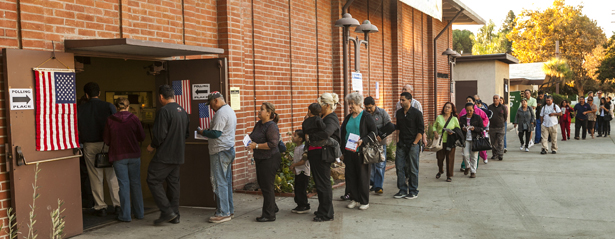
Voters stand in line in California. (AP Photo/Damian Dovarganes.)
Despite the clear fail of voter suppression efforts and the strong resolve of voters last year, right-wing forces are still determined to make voting harder. And despite the clear need for modernizing voter registration, conservative election officials are zeroing in on the registration process as a place to achieve their goals, by requiring proof of citizenship and adding unnecessary criteria for who can be registered and when.
At a recent Heritage Foundation panel, some of the biggest opponents of voting rights lined up to decry modernizing voter registration, calling it a “threat.” The moderator, the voter fraud wolf-crier Hans von Spakovsky, said solutions like universal voter registration and Election Day registration invite fraud and allow “non-citizens” to vote. There remains no evidence of ineligible voters throwing an election, or people from another country defrauding an outcome, or for that matter of meaningful incidents of any of the fraud these folks continue to insist exists. Still, at the panel Kansas Secretary of State Kris Kobach proclaimed “aliens” are stealing our votes and invading our voter rolls.
Popular
"swipe left below to view more authors"Swipe →The practice of restricting voter registration and making Americans prove their citizenship to vote has a long history in America, which sadly bears some review. White, wealthy elites have tried to keep the franchise from people of color, the poor and women since the start of this nation, often using registration as a barrier. It was during the civil rights movement, though, that these forces showed the nation that they were willing to try to beat the living black off people to stop them from registering.
Reading Gary May’s forthcoming Bending Toward Justice, I learned about the “Freedom Day” effort launched on October 7, 1963, by civil rights hero Jim Forman in Selma, Ala. Forman and his fellow SNCC soldiers wanted to capitalize on the momentum surge from the March on Washington, and the many civil and voting rights demonstrations before it. He teamed with comedian Dick Gregory, James Baldwin, Amelia Boynton and a host of civil rights soldiers to march to Selma’s courthouse and register African-Americans to vote.
But not before facing off with Selma Sheriff James Clark, whose sole reputation was to bust the heads of black voters. The night before Freedom Day, Forman hyped black Selmans up with a rousing speech where he told them to “call … people and tell them to come down to the courthouse tomorrow, that it’s freedom day.”
Anticipating long lines, he told them, “You take a baloney [sic] sandwich and a glass of cool water and go down there and stay all day.”
On Freedom Day, hundreds of black Selmans were lined up at the courthouse to register. Only a select few were allowed in, and to register they had to pass oral and written tests to prove they were worthy to vote. May writes that, “[Sheriff] Clark’s men took pictures of those inside [the courthouse], another deterrent to registering.”
Clark’s men: fifty state troopers and forty others that May describes simply as a “posse,” all armed with guns, cattle prods and night sticks.
Two of Forman’s aides, Carver Neblett and Avery Williams, tried to bring food to the people who had been waiting in line for hours. They were met by state troopers’ billy clubs. Neblett and Williams were carted off to jail, where the beatings continued. Would-be voters who had been standing in line all day to register were told to go home. Later, John Lewis would declare this “the turning point in the right to vote.”
Today, 50 years later, African-Americans and thousands of other voters continue to wait in long lines. The people who tried to give water and food to those in long lines last year were still being challenged and blocked. Masses of people of color showing up to exercise their voting rights are still viewed with suspicion. Groups like True the Vote continue to take voters’ pictures, and registration procedures are still poorly explained.
It could be that we don’t even need voter registration, especially since it seems to have a history rooted in keeping many from voting. North Dakota has no voter registration system. People show up on Election Day, show a form of ID—from a wide range of acceptable forms, not a narrow photo ID rule—and then sign their names into an electronic pollbook. That’s it. The record of voters are entered into a centralized database.
I talked with North Dakota Secretary of State Al Jaeger about how he runs these registration-less elections and he was proud that they’d been doing it this way since the 1950s “without incident.”
In his state, “There’s no reason to have voter registration drives and from what I can tell with all the voter registration guidelines out there and voter lists, there seems to be a lot of problems and challenges.”
He doesn’t know if his system is perfect, but he knows “that in North Dakota dead people don’t vote.”
Yet US history shows plenty of black people dead from trying to vote. The nation probably needs a voter registration system, or at least a national database that stores and tracks voters’ information so that it automatically updates whenever a person moves, gets married or dies. But demanding people to prove their citizenship or their worthiness to vote is a retreat to the past, a past that bends away from justice.
—Brentin Mock
Previously, Brentin Mock delved into Virginia’s gerrymandered electoral map.


